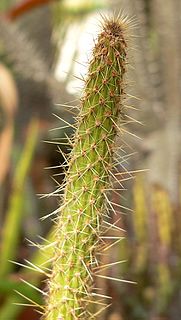Related Research Articles

Leocereus bahiensis is a species of cactus and the only species of the genus Leocereus.

Brasiliopuntia is a genus in the cactus family, Cactaceae. It contains only one species, Brasiliopuntia brasiliensis.
Phoneutria bahiensis is a species of spiders in the family Ctenidae, found in Brazil. It's known in brazilian portuguese as Armadeira da Bahia,.
Kalyptodoras bahiensis is the only species in the genus Kalyptodoras of the catfish family Doradidae. This species is endemic to Brazil where it is found in the Paraguaçu River in the northeast and reaches a length of 24.5 centimetres (9.6 in) SL.
Cratylia bahiensis is a species of legume in the family Fabaceae. It is found only in Brazil.
Arrojadoa bahiensis is a species of plant in the family Cactaceae. It is endemic to Brazil. Its natural habitat is rocky areas.

Euplassa is a genus of flowering plants in the protea family.

Rhodocactus bahiensis is a species of tree-like cactus that is endemic to the Brazilian state of Bahia. First described as Pereskia bahiensis, it was transferred to Rhodocactus in 2016. Like all species in the genus Rhodocactus, and unlike most cacti, it has persistent leaves. In its native locality, it is used to form hedges.
Rollinia bahiensis is a species of plant in the Annonaceae family. It is endemic to Brazil. It is threatened by habitat loss.
Philcoxia is a genus of seven rare plant species in the Plantaginaceae that are endemic to Brazil and resemble terrestrial species of the genus Utricularia. The genus, formally described in 2000, consists of the species P. bahiensis, P. goiasensis, P. minensis, P. tuberosa, P. rhizomatosa, P. maranhensis and P. courensis, each of the first three named for the Brazilian state to which it is endemic. The species are characterized by subterranean stems, peltate leaves at or below the soil surface, and five-lobed calyces. Their habitat has been reported as areas of white sand in the midst of cerrado vegetation at an elevation between 800 and 1450 m. Initial descriptions of the genus included suspicions that the plethora of stalked capitate glands on the upper surfaces of leaves was an indication that these species may be carnivorous. A study published in 2007 tested P. minensis for protease activity, a typical test for the carnivorous syndrome, and could detect none. Later studies detected other digestive enzymes such as phosphatases and qualitatively assessed prey digestion and nutrient uptake, suggesting that it is a true carnivorous plant. The genus epithet honors David Philcox, a botanist at Kew Gardens who worked extensively in tropical Scrophulariaceae.
Scherya is a genus of flowering plants in the daisy family, Asteraceae. The only known species is Scherya bahiensis, native to the State of Bahia in eastern Brazil.

Acanthoderini is a tribe of longhorn beetles of the subfamily Lamiinae. It was described by Thomson in 1860.
Cotycicuiara alternata is a species of beetle in the family Cerambycidae. It was described by Galileo and Martins in 2008. It is known from Brazil.
Cotycicuiara boliviana is a species of beetle in the family Cerambycidae. It was described by Galileo and Martins in 2008. It is known from Bolivia.
Cotycicuiara latifascia is a species of beetle in the family Cerambycidae. It was described by Galileo and Martins in 2008. It is known from Bolivia.
Cotycicuiara multifasciata is a species of beetle in the family Cerambycidae. It was described by Galileo and Martins in 2008.
Cotycicuiara venezuelensis is a species of beetle in the family Cerambycidae. It was described by Galileo and Martins in 2008.
Rhinosardinia bahiensis, commonly known as the Bahia spat, is a ray-finned fish in the family Clupeidae. It is found in South America, residing in freshwater, brackish, and pelagic environments in a tropical climate. It has 13 to 21 dorsal soft rays, 15 to 18 anal soft rays, and 43 vertebrae.

Discocactus bahiensis is a species of Discocactus from Brazil.
Sebastiania bahiensis is a species of flowering plant in the family Euphorbiaceae. It was originally described as Gymnanthes bahiensisMüll.Arg in 1863. It is native to Bahia, Brazil.
References
- ↑ BioLib.cz - Cotycicuiara bahiensis. Retrieved on 8 September 2014.